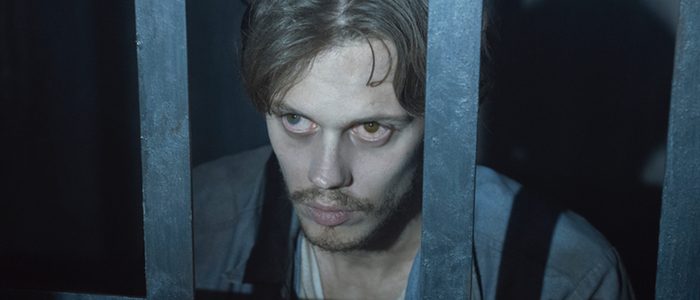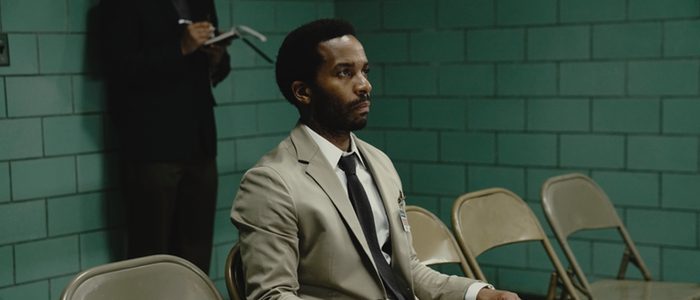‘Castle Rock’ Review: ‘Severance’, ‘Habeas Corpus’, and ‘Local Color’ Welcome You to Stephen King Country
Welcome to our spoiler-filled Castle Rock reviews, in which we explore Hulu’s new Stephen King-inspired series. (If you’re looking for a spoiler free review of the show, click here). This week we kick things off with the first three episodes: “Severance”, “Habeas Corpus” and “Local Color.”
Severance
There’s one thing many filmmakers miss when adapting the work of Stephen King: character is key. Too often, people think of King as a brand – a familiar name to slap on a product with hopes that will be enough to give the audience a thrill. But King’s work is comprised of more than things that go bump in the night. What really makes King tick is his incredible ability to paint realistic characters with only a few words. In almost every King novel, we know exactly who his characters are the minute he introduces them to us. It’s almost like a magic trick – the author uses mannerisms (accents, bad habits, repeated phrases almost like mantras) to establish his characters, to burn them into our brain.
Castle Rock gets this. It understands that in order to create a world within the realm of Stephen King, character has to come first, and horror has to come second. The first episode of the new Hulu series set within the familiar world of Stephen King is devoted almost entirely to establishing character, and while this is commendable, it also backfires slightly. As “Severance” unfolds, it becomes clear that Castle Rock is going to be a slooooowwww burn. It’s going to take its time, like it or not. It also becomes clear that this is very much a “Mystery Box” series, just as much in the world of executive producer J.J. Abrams as it is Stephen King. While this may hook audiences, it also rings a little false – King dabbles in mystery, but never to this extent.
“Severance” begins in the midst of a bone-chilling Maine winter. It’s 1991, and Castle Rock Sheriff Alan Pangborn wanders the woods, looking for something. Or someone. Soon, he finds what he’s looking for: Henry Deaver. The young boy has been missing, and he returns seemingly in the blink of an eye. One minute, Pangborn is looking out over the vast, frozen body of water of Castle Lake. Nothing is there. And then, there’s Henry. Standing in the dead center. Even though Henry has been missing for days, he shows no signs of frostbite. Which means he couldn’t have been outside for very long. And just how the hell did he materialize from thin air like that?
That’s a question for another episode, because we’re instantly thrust into the present. Castle Rock is a dying town – abandoned lots, burned down homes. A general sense of death settles over everything. The only booming business in town is Shawshank Prison, and the ‘Shank and everyone involved with it is about to get a rude awakening. Because the prison’s warden, Dale Lacy, (Terry O’Quinn) has decided to take himself out of the equation in a spectacular fashion. After looping a rope around a tree on top of a cliff overlooking Castle Lake – the same Castle Lake we saw frozen over so many years ago – Lacy ties the other end around his neck. He then gets into his car and floors it. The car sails over the cliff, the rope cinches around Lacy’s neck, and off goes his head. (Thus the title, “Severance.” )
Lacy’s death is just the beginning of the strange goings-on. After a new warden arrives at Shawshank, she discovers that an entire block of the prison –Block F – has been closed off and unused since 1987 – despite the fact that Shawshank has an overcrowding problem and is running out of room for its inmates. The warden orders the abandoned block inspected. Two guards descend into the dark and murky block – a place ravaged by fire many years ago. One of the guards – Zalewski (Noel Fisher) – finds something. Or rather, someone. A young man (It star Bill Skarsgård), filthy, disheveled, and locked away in a cage hidden away in an empty water tank. The Kid, as he’s called, doesn’t speak much. In fact, there’s only one thing he says: a name, Henry Deaver. It’s a name Zalewksi instantly recognizes. Indeed, it’s name every Castle Rock resident might recognize. Because Henry Deaver has a history in the town. The townspeople think Deaver faked his disappearance all those years ago, and in the process, his adopted father, a pastor, shuffled off this mortal coil. Perhaps at Henry’s hand.
And where is Henry Deaver (André Holland) now? He’s in Texas, serving as a defense lawyer for death row inmates. And no matter how good his closing arguments may be, he can’t seem to convince a jury to spare the life of a woman who killed her abusive husband. Later, as she eats her last meal, the doomed woman, pondering her imminent death, murmurs, “What I keep wondering: all the smells we smell; songs and pictures – do you lose them all? Wherever you go next, does the tape get erased? And if it does, you’re not really you anymore, are you?”
“Is that what you’re afraid of?” Henry asks, his own past flooding back in flashes of brief, silent scenes.
“That’s what I want,” the condemned woman replies. It’s a particularly haunting moment, and it resonates with Henry. It’s clear he has a few things from his past he’d like to erase.
What follows is nightmarish – Henry is the only witness to the woman’s execution, and it goes terribly wrong. The lethal injection fails to kill her, and in a fit of rage and panic, Henry attempts to break into the death chamber to stop the executioners from trying again.
He fails. Failure seems to be his lot in life. Hanging around his neck like a millstone.
And then he’s called home. Zalewski has managed to track Henry down, and he calls him in Texas to tell him about the Kid. Rather than release the Kid and create a public relations nightmare, the new warden is keeping him locked away and hidden in Shawshank. Zalewski, who seems to be the only employee at Shawshank with any sort of empathy, urges Henry to return to Castle Rock to help.
Henry does not find Castle Rock to be warm and inviting when he returns. “Hello, killer,” a stranger on the street calls out to him. Local real estate agent Molly Strand (Melanie Lynskey, who steals the entire show), spots Henry getting off a bus and is instantly panicked. Molly has problems of her own. She buys drugs – Oxycodone we learn in a later episode – from a local high school kid to help with a physical – or mental – issue. She also just happens to have a box of memorabilia in her basement devoted solely to Henry Deaver.
Back at his childhood home, Henry’s adoptive mother Ruth (Sissy Spacek) is suffering from Alzheimer’s and doesn’t even recognize him. Ruth is now living with Pangborn (Scott Glenn), the former sheriff who found Henry all those years ago. Henry is not pleased about this revelation. He’s also not pleased to learn that the graveyard where his father was buried has been relocated – the graves dug up and planted somewhere else, due to financial reasons. “My experience, the dead are not particular,” says Pangborn.
And what of the Kid? He’s cleaned up and located to a much nicer cell than his former cage, but it’s clear there’s something very, very wrong with him. His dead gaze, his stillness. He’s like a corpse that occasionally moves. And one night, while Zalewski watches him on the security monitor, the Kid suddenly moves quite a bit. In fact, he seemingly moves through walls, like a ghost. Or does he? Is Zalewski hallucinating? Is the Kid supernatural? Just what in the hell is going on here? In a flashback sequence, we see Lacy tell the caged Kid to ask for Henry Deaver when he’s discovered by the Shawshank staff. Why? Seriously…what is happening here?
As far as first episodes go, “Severance” leaves something to be desired. There’s a lot of set-up here, and there’s the troubling suspicion that the series might follow the Lost model and never get around to addressing all the mysteries it’s setting up. What the show does have going for it is its cast. Holland makes for a charming leading man. He wanders through the show with a perplexed look on his face, occasionally slipping into cockiness. He’s the lone black face in a town of white people, and he stands out, and then some. Spacek doesn’t have much to do in this first episode, but she makes the most of her “sundowning” character. She also gets a laugh when she politely tells Henry, “I adopted a black son!”, completely unaware that said son is standing right before her.
Glenn instantly makes an impression as the gruff, miserable, no bullshit Pangborn. His tense interactions with Holland make for uneasy-yet-enjoyable viewing. Lynskey, like Spacek, doesn’t get a whole lot here, but she’ll eventually become one of the most essential members of the cast. And then there’s Skarsgård. The actor got to go big and broad as Pennywise the Clown in It. Here, his character is quiet and mysterious. It’s far more creepier than the work he did as Pennywise – the actor has a unique ability to give you the creeps with just a glance.
Castle Rock doesn’t hit its stride right out of the gate. We find ourselves intrigued by the show’s mysteries, but not quite engrossed. And despite a wealth of references, it doesn’t really feel like a Stephen King story. Not yet at least. But there are better, creepier things to come.
I Understood That Stephen King Reference!
- Shawshank is, of course, the prison from King’s short story Rita Hayworth and the Shawshank Redemption, later turned into the the film The Shawshank Redemption. When the new warden checks into the prison, a guard begins to talk about a bullet hole in the wall of the warden’s office. This is the hole from when the Shawshank warden (played by Bob Gunton in The Shawshank Redemption) killed himself.
- When Warden Lacy drives through Castle Rock before his suicide, he listens to the same section of The Marriage of Figaro that Tim Robbins’ character played in The Shawshank Redemption in this scene.
- Alan Pangborn is the only character here explicitly from King’s work. The character appeared in King’s novels The Dark Half and Needful Things. In the respective film adaptations of those books, Pangborn was played by Michael Rooker and Ed Harris. The Pangborn of the books is haunted by the death of his wife and son in a car crash, but that doesn’t seem to be carried over into Castle Rock‘s interpretation of the character.
- It’s not an direct reference, but at one point, the Kid sees a mouse scurrying through the prison. King’s The Green Mile prominently features a mouse in a prison, but the rodent here meets an untimely demise, while the Green Mile mouse, Mr. Jingles, lived for a very, very long time.
Continue Reading Castle Rock Reviews >>
The post ‘Castle Rock’ Review: ‘Severance’, ‘Habeas Corpus’, and ‘Local Color’ Welcome You to Stephen King Country appeared first on /Film.
from /Film https://ift.tt/2JVZIFh



No comments: